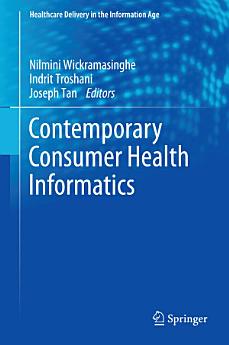Contemporary Consumer Health Informatics
Nilmini Wickramasinghe · Indrit Troshani · Joseph Tan
មីនា 2016 · Springer
សៀវភៅអេឡិចត្រូនិច
465
ទំព័រ
reportការវាយតម្លៃ និងមតិវាយតម្លៃមិនត្រូវបានផ្ទៀងផ្ទាត់ទេ ស្វែងយល់បន្ថែម
អំពីសៀវភៅអេឡិចត្រូនិកនេះ
This innovative reference examines how consumer health informatics (CHI) can transform healthcare systems stressed by staffing shortages and budget constraints and challenged by patients taking a more active role in their care. It situates CHI as vital to upgrading healthcare service delivery, detailing the relationship between health information technologies and quality healthcare, and outlining what stakeholders need to learn for health IT systems to function effectively. Wide-ranging content identifies critical issues and answers key questions at the consumer, practitioner, administration, and staff levels, using examples from diverse conditions, countries, technologies, and specialties. In this framework, the benefits of CHI are seen across service domains, from individual patients and consumers to healthcare systems and global health entities. Included in the coverage:
- Use of video technology in an aged care environment
- A context-awareremote health monitoring service for improved patient care
- Accessibility issues in interoperable sharing of electronic health records: physician’s perspective
- Managing gestational diabetes with mobile web-based reporting of glucose readings
- An organizing vision perspective for developing and adopting e-health solutions
- An ontology of consumer health informatics
អំពីអ្នកនិពន្ធ
Prof. Nilmini Wickramasinghe, PhD; MBA; Grad.Dip.Mgt.St.; BSc Amus.A, piano; Amus.A, violin; has a well-recognised research record in the field of healthcare and IT/IS. Her expertise is in the strategic application and management of technology for effecting superior healthcare solutions. She currently is the professor-director of Health Informatics Management at Epworth HealthCare and a professor at Deakin University in Victoria, Australia.
Dr. Indrit Troshani is a senior lecturer in Information Systems at the University of Adelaide Business School in Australia. He holds a PhD from Edith Cowan University (Western Australia) and an MSc (Sunderland, UK). His research interests include adoption and diffusion of network innovations and mobile services in the healthcare and financial services industries. His work has been published in several journals including Information Technology & People, ElectronicMarkets, Journal of Computer Information Systems, Journal of Engineering and Technology Management, and Industrial Management & Data Systems.
Prof. Joseph Tan specialises in innovative design, implementation, and diffusion of advancing e-technology to improve health services delivery system efficiencies and effectiveness. His research interests cut across multiple disciplines, with emphasis on the application of strategic e-business and e-health models to improve health systems operational efficiencies, individual or group decision effectiveness, and community health behaviours. He teaches health IT project management and special topics in e-health.
Dr. Indrit Troshani is a senior lecturer in Information Systems at the University of Adelaide Business School in Australia. He holds a PhD from Edith Cowan University (Western Australia) and an MSc (Sunderland, UK). His research interests include adoption and diffusion of network innovations and mobile services in the healthcare and financial services industries. His work has been published in several journals including Information Technology & People, ElectronicMarkets, Journal of Computer Information Systems, Journal of Engineering and Technology Management, and Industrial Management & Data Systems.
Prof. Joseph Tan specialises in innovative design, implementation, and diffusion of advancing e-technology to improve health services delivery system efficiencies and effectiveness. His research interests cut across multiple disciplines, with emphasis on the application of strategic e-business and e-health models to improve health systems operational efficiencies, individual or group decision effectiveness, and community health behaviours. He teaches health IT project management and special topics in e-health.
វាយតម្លៃសៀវភៅអេឡិចត្រូនិកនេះ
ប្រាប់យើងអំពីការយល់ឃើញរបស់អ្នក។
អានព័ត៌មាន
ទូរសព្ទឆ្លាតវៃ និងថេប្លេត
ដំឡើងកម្មវិធី Google Play Books សម្រាប់ Android និង iPad/iPhone ។ វាធ្វើសមកាលកម្មដោយស្វ័យប្រវត្តិជាមួយគណនីរបស់អ្នក និងអនុញ្ញាតឱ្យអ្នកអានពេលមានអ៊ីនធឺណិត ឬគ្មានអ៊ីនធឺណិតនៅគ្រប់ទីកន្លែង។
កុំព្យូទ័រយួរដៃ និងកុំព្យូទ័រ
អ្នកអាចស្ដាប់សៀវភៅជាសំឡេងដែលបានទិញនៅក្នុង Google Play ដោយប្រើកម្មវិធីរុករកតាមអ៊ីនធឺណិតក្នុងកុំព្យូទ័ររបស់អ្នក។
eReaders និងឧបករណ៍ផ្សេងទៀត
ដើម្បីអាននៅលើឧបករណ៍ e-ink ដូចជាឧបករណ៍អានសៀវភៅអេឡិចត្រូនិក Kobo អ្នកនឹងត្រូវទាញយកឯកសារ ហើយផ្ទេរវាទៅឧបករណ៍របស់អ្នក។ សូមអនុវត្តតាមការណែនាំលម្អិតរបស់មជ្ឈមណ្ឌលជំនួយ ដើម្បីផ្ទេរឯកសារទៅឧបករណ៍អានសៀវភៅអេឡិចត្រូនិកដែលស្គាល់។




